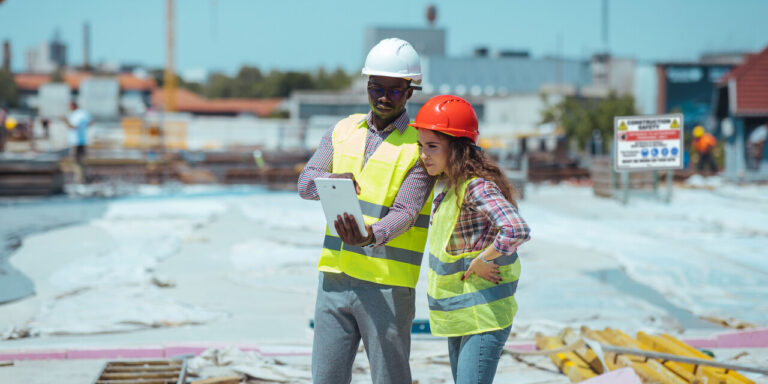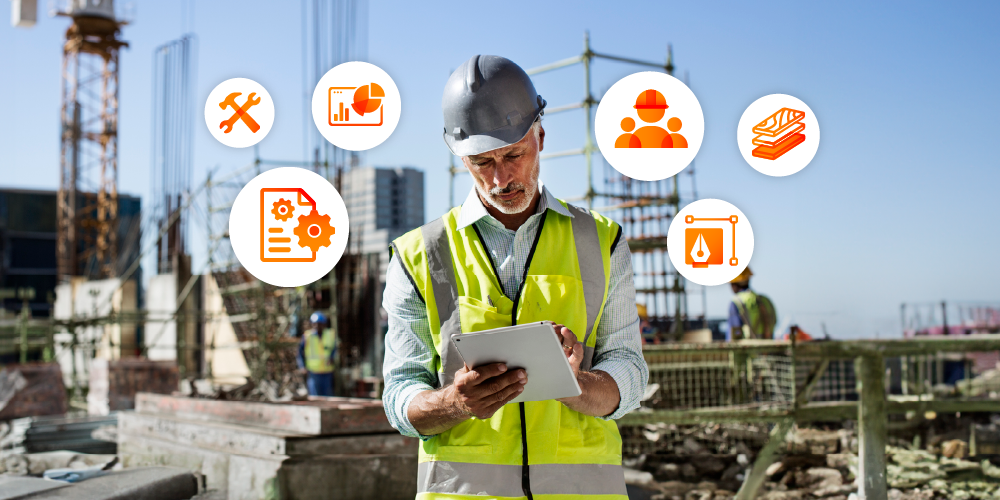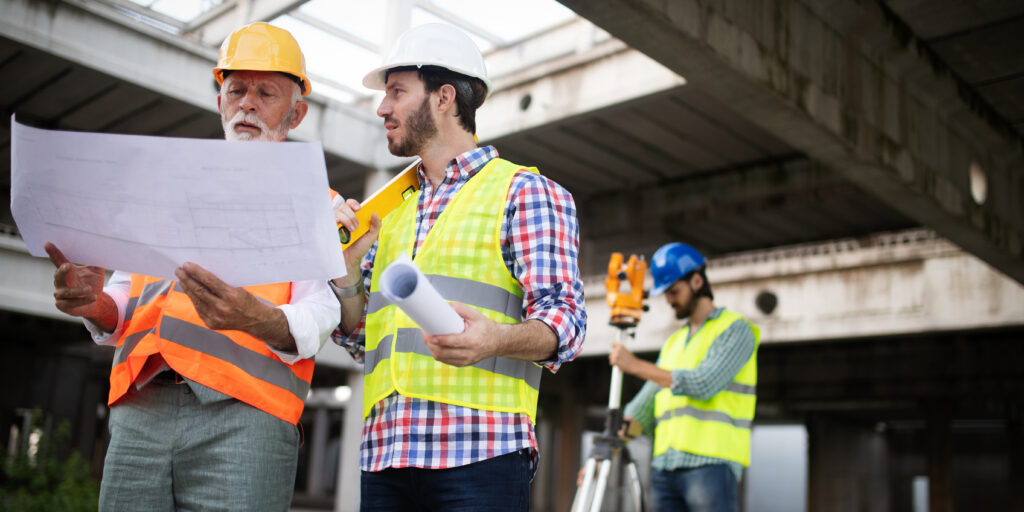— 10 min read
Risk Management in Construction
Last Updated Mar 26, 2025
Last Updated Mar 26, 2025

Risk management is key to a smooth, on-time construction project. In construction, risk management is the systematic process of identifying, assessing, prioritising, and controlling uncertain events that could affect the successful delivery of a project. To put it simply: it’s working out what could go wrong (or better) and then working out how to stop it from going wrong (or how to ensure it does go better).
Strong risk management must be part of construction management, as it ensures that projects stay within budget and timeline constraints. It also helps to prevent situations that could cause a client to be unhappy with the outcome of a project, or that could cause financial or reputational damage for the construction company.
It’s all about trying to understand what the uncertainties of a project’s delivery are, and what effects those events could have in terms of quality, timeline, delivery, costs, safety, and other important factors.
Thomas Richardson
Strategic Industry Advisor, Europe
Procore
Table of contents
Why is risk management important in construction?
All industries face uncertainty in some form, and construction is no different. But unlike most manufacturing tasks, construction tends to involve more unique, standalone projects where the basic variables cannot help but be different.
Health and safety is always at the front of people’s minds when they think about risks on a construction site. After all, the most severe risks carry the potential for serious injuries or even death. For this reason the management of health and safety on site is a specialist role, and in the UK the Construction (Design and Management) Regulations 2015 (CDM 2015) requires the appointment of a Principal Designer on any project where multiple contractors are working.
It is the role of the Principal Designer to take the lead in planning, managing, monitoring, and coordinating health and safety during the pre-construction phase (design and planning stage) of a project. Once construction begins, the Principal Contractor — the contractor appointed in writing by the client (commercial or domestic) — is responsible for planning, managing, monitoring, and coordinating health and safety.
While historical research has revealed examples of risk management processes practised by ancient Egyptians and Babylonians, the modern practice of risk management became an established part of project management in the 1990s. Its importance is highlighted by its position as one of the 10 knowledge areas detailed in the Project Management Institute’s publication the Project Management Body of Knowledge.
There are many stories in construction of projects that failed due to unforeseen events, but supporters of risk management will argue that for a lot of those cases, the events should have been foreseen — or at the very least some kind of plan to allow the project to adapt should have been in place.
It’s not enough to think “We don’t want it to happen.” You’ve got to think “What do we do if it does happen?
Thomas Richardson
Strategic Industry Advisor, Europe
Procore
Shape the Future of the Built Environment at Procore's Construction Summit
Engage with construction leaders and discover the latest technology and best practices that are driving change across the industry.

Types of Risks in Construction
There are a broad range of risks that could affect a construction project, each with different levels and kinds of impact. Here are five categories of risks and some examples of situations that could affect a construction project or business.
Operational Risks
These are risks that affect the efficiency, productivity, or success of a construction project. They include:
+ Supply chain shortages or delays
+ Labour shortages
+ Equipment failures
Health and Safety Risks
Health and safety risks must be front of mind on a building site as workers are exposed to heavy machinery, potentially hazardous materials, and are often working at height. Common health and safety risks include:
+ Accidents and injuries
+ Mental health issues
Financial Risks
Financial risks can stem from a variety of factors during a construction project. Some of the most common financial risks include:
+ Unexpected materials costs
+ Unexpected labour costs
+ Budget overruns
+ Economic downturns
+ Fines
Environmental Risks
Environmental risks are risks that happen due to natural causes or the pre-existing conditions of the site and aren’t always easy to predict or prevent. Some examples of environmental risks are:
+ Poor weather conditions
+ Natural disasters like floods or severe storms
+ Site conditions such as soil quality
In the UK, the first risk on a construction project is commonly what you’re going to hit when you first dig into the ground. It could be the water table, it could be archaeological, it could even be an unexploded bomb! Surveys and mapping help, but there’s always an element of risk.
Thomas Richardson
Strategic Industry Advisor, Europe
Procore
Legal and Regulatory Risks
Legal and regulatory risks are all about compliance with the law and with specific regulations that apply to construction projects and companies. These are severe risks that could result in legal action or financial penalties if they are not strategically avoided. This category of risk includes:
+ Contract disputes
+ Non-compliance with the Building Regulations
+ Permits and planning laws
Roles and Responsibilities in Risk Management
Successful risk management is a team effort. Everybody in the project team has a role to play to prevent and manage risks. Let’s break down the responsibilities of the main roles in construction risk management:
Risk Manager
Not all projects will have a Risk Manager — it tends to be larger projects that have a dedicated role for managing risk. A Risk Manager is in charge of developing a risk management plan and making sure that it is properly implemented at all times during the project. They are also responsible for communicating the plan, identifying risks, and conducting risk assessments. This role sits in the project management office (PMO).
My role as a Risk Manager was to facilitate conversations around risk by holding workshops with project teams to identify, assess, and strategise for risks. Procore's functionality, for instance, enables easy risk identification and quick sharing of risk information across the project team. This makes the process much more efficient and prominent on the project.
Thomas Richardson
Strategic Industry Advisor, Europe
Procore
Safety Officer or Health and Safety Manager
These roles make sure that the working environment is safe for everybody who needs to be present on the site. Safety Officers and Health and Safety Managers work to identify and prevent any risks that could cause injury, illness, or even death. They are also responsible for making sure that the team is compliant with health and safety regulations such as the CDM 2015. People in these roles conduct safety audits and risk assessments. They also provide training to help workers understand safe practices and hazard awareness.
Planning Manager
The Planning Manager (or programmer, scheduler, or planner) is responsible for managing the timelines for all work in a construction project. Planning and organising the schedule of work minimises delays. They must also create contingency plans for risks that could affect timelines or cause delays. Their role includes monitoring risks to the programme and communicating updates with senior leadership and stakeholders.
HS2 is a great example to see how delay risks can affect a project: the costs have escalated due to project complications and delays in decision making. A delay early on can have a significant impact on later stages, increasing overall costs simply by the effect of inflation.
Thomas Richardson
Strategic Industry Advisor, Europe
Procore
Risk Management Techniques
There are many different risk management techniques that help Risk Managers and other construction workers to stay on top of risks and make sure they are dealt with properly. These techniques can be split into five different categories:
Identification
Identifying risks is the first stage of risk management. Risk identification involves conducting site audits, holding workshops, and looking at resources such as the Health and Safety Executive guidelines to pinpoint potential risks to a project. Once risks have been identified, they can be assessed to evaluate probability and impact, and then prioritised based on those assessments
People often want a list of common risk occurrences, but the best approach is to start from scratch in a workshop to identify risks and think about factors specific to the project.
For instance, in Southwark, a Museum of Gardening is next to Lambeth Palace (the official London residence of the Archbishop of Canterbury). The museum was awarded some funding to build an extension. I don’t know what the assessment of the ground risks were when the project kicked off, but once they started the excavations they found a tomb containing the remains of several former Archbishops.
It goes to show how you can’t predict every risk with a standardised checklist.
Thomas Richardson
Strategic Industry Advisor, Europe
Procore
Risk Mitigation and Other Risk Responses
Once risks have been identified, assessed, and prioritised, teams need to agree on their strategies for dealing with these risks. These are commonly divided into four approaches: avoid, transfer, mitigate, and accept.
Avoiding strategies can go as far as cancelling the whole project, while transferring risk is commonly done via insurance. Mitigating a risk, by taking action to reduce the likelihood or impact of the risk, is where project teams can really demonstrate their skills and experience. It is necessary in order to avoid, prevent, and mitigate any risks that could have these negative effects on a project — and the people and parties involved. Even if the project chooses to accept the risk, good risk management will also include planning what to do when that thing does go wrong.
Risk Monitoring and Control
This is the ongoing part of risk management that happens throughout the entire construction project. It includes constant surveillance, checking for any early signs of a risk arising by using tools such as project management software for real-time tracking.
Review and Optimisation
Risk review and optimisation is the part of risk management that happens after a construction project is completed. It involves looking at the risk management for the project, including what risks were identified and avoided, risks identified during the project, and which, if any, risks became active problems that required action to eliminate or control. Lessons learned can be incorporated into planning future projects.
Review and optimisation are essential to developing and maintaining a culture of continuous improvement within the UK’s evolving construction landscape.
Challenges Affecting Risk Management
Risk management can be a tricky part of construction work. Here are some common challenges that affect risk management in construction:
High Levels of Complexity
Large projects with lots of different phases or activities will also have more risks. Projects with wider scope and scale will involve greater diversity of risks, and more stakeholders who need to be involved with risk management and awareness. The longer the timescales of the project, the more difficult it is to try to work out when a risk could occur. Excellent documentation and communication are important here.
Resistance to Change
As new technology and techniques emerge, construction teams must adapt to new ways of working to identify and manage associated risks. This can be a difficult task, as experienced workers who have become accustomed to certain ways of working may find it challenging to change their working styles. Regular, high-quality communication on the importance of adapting to new risks is vital to getting workers on board with new ways of managing risk.
Limited Resources
Smaller companies may not have the resources to have a dedicated Risk Manager, which means that risk identification and management becomes more of a collaborative effort. It’s important that there are clear, defined roles and responsibilities so that risks are properly identified, assessed, and managed — even without a dedicated risk team or manager.
Frequently Asked Questions
What unexpected risks can affect a construction project?
There are always risks that could arise without warning. Some of these include unexpected staff turnover, archaeological findings, technology failures, cybersecurity threats, and geopolitical issues like the pandemic and Brexit.
How has risk management changed in recent years?
Risk management has changed a lot, even in the last five years. The construction industry has gone from mainly using Excel spreadsheets to manage risk, to now using construction-specific project management tools like Procore and even AI tools. These tools can reduce the risk of human error and bias, and carry out more complex analysis.
What developments are likely to change the way we manage risk in construction?
AI agents are an exciting technological development — we’re approaching an era where risk teams can have their own AI agent that they talk to that can help them to identify and assess risks, and even communicate those risks to the rest of the team.
Categories:
Tags:
Written by
Thomas Richardson
Thomas Richardson is an expert in strategic product consulting and risk management, currently working as a Strategic Industry Advisor for Procore Technologies in Europe. His career includes roles such as Principal Risk Consultant at WSP and various consulting positions at Currie & Brown and Sweett Group. He holds an MBA with a concentration in Marketing and Innovation from SDA Bocconi and a degree in Estate Management from London South Bank University. Thomas is certified as a Procore Administrator and Project Manager in Financial Management.
View profileReviewed by
Nicholas Dunbar
29 articles
Nick Dunbar oversees the creation and management of UK and Ireland educational content at Procore. Previously, he worked as a sustainability writer at the Building Research Establishment and served as a sustainability consultant within the built environment sector. Nick holds degrees in industrial sustainability and environmental sciences and lives in Camden, London.
View profileExplore more helpful resources

Construction Document Software: Essential Tools for Project Success
Construction projects depend on extensive paperwork, including designs, contracts, RFIs, and compliance records. A single misplaced document can trigger delays, disputes, or compliance violations. Despite increasing digital adoption, many teams...

Construction Planning: A Guide to Successful Project Execution
Every successful construction project begins long before the first brick is laid. Indeed, behind each structure – whether a towering skyscraper or complex infrastructure project – lies a carefully crafted...

Leveraging Analytics for Better Financial Forecasting in Construction
Financial forecasting is a difficult task in any industry. In construction, where companies need to manage volatile material costs, labour shortages and variation orders on a daily basis, fluctuations in...

Strategies to Prevent Rework: The Importance of Clear Instructions
In construction, “rework” is the dreaded process of redoing tasks due to mistakes, quality issues, or safety concerns. This unnecessary work drains budgets through wasted materials and labour while causing...